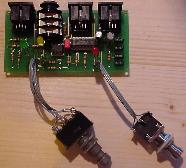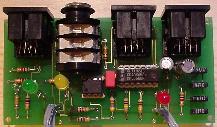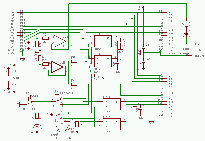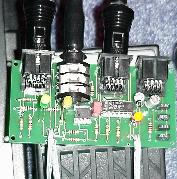

 |
 |

The Eagle files linked below are Copyright Harald Milz 2001, and put under the GNU General Public License. Commercial use requires a license from me which has to be negotiated, and a license from Cadsoft which is available from their web site. If you make any modifications please send them to me to allow me keeping track of what you did.
The PCB was designed and mostly autorouted using Eagle. The Eagle files are here. A free version of the Eagle layouter for educational use is available from Cadsoft. (Remark: these are the files for board revision 2. The files for rev. 1 are here.) If you have no means to make a double-sided PCB with through contacts I can have some PCBs made for you. They are about 50 DEM each.
My prototype worked out of the box so it should be quite DIY safe. Rev 1 of the board contains some errors which have been corrected in Rev. 2. Rev 1 is not longer supported except for people who bought the PCB. New projects should always get Rev. 2 from the links above.
Footswitches: I reused a DPDT switch from an older stompbox, and bought a new SPDT switch. Simply solder some 3-wire flat ribbon strands to the solder terminals on the PCB and the respective terminals of the switched (see pic above). The sequence doesn't matter just make sure the middle terminal on the PCB is connected to the middle terminal of each respective switch.
Alternatively, you can connect 2 relays (DPDT and SPDT, respectively) and have them switched by a MIDI device. This way you can change the settings using MIDI. I don't know how much current you can draw from a GK device (the US-20 draws +/- 7V from port A) so be sure not to spoil your GK toys. This is not for the beginner! You have been warned.
If you have 2 GK compliant devices it is likely you have one spare GK cable. The easiest way to get 2 short (1 - 1.5m) cables is to cut the spare cable in halves, and solder 13-pin male plugs to the bare ends.
Plank has got a file showing the colorcode to pin assignment in the a.m. file area. It is sort of useful to give you a rough idea but my cable had completely different colors and pin assignments. Use an ohmmeter to find the assignments and document them for your use. There is no magic to this - just make sure all colored wires are soldered to the same pins on both sides, respectively.

Soldering the tiny wires to the male plug isn't trivial. My plugs just had 13 pins on the backside, no soldering pockets! Be sure not to use too much solder otherwise you run the risk of getting shorts which can put your precious Roland parts on risk! Double check the wiring! Use a bench vice or something to properly fix the plug before soldering. Otherwise your mental state is on risk.
In order not to get any shorts within the plug you may want to wrap some isolating tape around all pins, or use a thin isolating plastic tube.
Lotsa warnings. Don't worry if you have good EE skills. I built the interface including the cables in slightly more than 3.5 hours (the case is still missing, though), and double and triple checked everything to be on the safe side.
Another US-20 clone project, albeit without a PCB.
To my other electronic projects